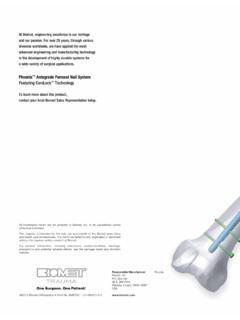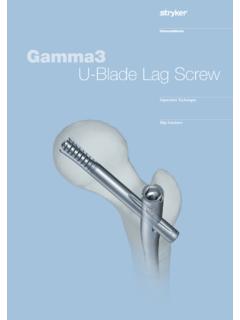Transcription of DHS/DCS System. Including LCP DHS - OSTEOSYNTESE.dk
1 DHS/DCS system . Including LCP DHSand DHS 14:32 Uhr Seite 14:32 Uhr Seite Cvr2 Synthes1 WarningThis description is not sufficient for immediate application ofthe instrumentation. Instruction by a surgeon experienced inhandling this instrumentation is highly of ContentsImage intensifier controlIntroductionSurgical TechniqueProduct InformationBibliography45 system Overview2 Features and Benefits4 Indications and Contraindications6 Clinical Cases8 DHS Implantation10 DHS Removal24 LTSP Implantation26 LTSP Removal31 DCS Implantation32 DCS 14:32 Uhr Seite 12 SynthesDHS / DCS system Technique GuideSystem OverviewThe Synthes Dynamic Hip system (DHS) offers a variety oftreatment options depending on the fracture site and the patient. fixation elementsDHS ScrewThe well-proven standard for proximal femur fractures.
2 Stainless steel / TiAl6Nb7 (TAN) Length 50 145 mm Outer diameter mm Coupling: two flats or octagonalDHS BladeThe DHS Blade is mainly indicated for osteoporotic reduces the risk of cut-out compared to the standard DHSS crew. Stainless steel / TAN Length 65 145 mm Outer diameter mmDHS Emergency ScrewIndicated for revisions in young patients. Stainless steel Length 50 145 mm Outer diameter 14 mmPlatesDHS plate with DCP holesUsed for more than 25 years. Stainless steel / TAN Barrel angle 130 150 2 to 20 holes Barrel length: 25 and 38 mm Thickness mm fixation with cortex screws mmLCP DHS plateBetter fixation on the shaft allows for minimally invasive approach. LCP combi-holes Tapered end Undercuts Barrel angle 130 150 1 to 20 holes Barrel length: 25 and 38 mm Thickness mm fixation with locking screws mm, cortex screws mm or a combination of 14:32 Uhr Seite 2 Synthes3 DHS Trochanter Stabilizing PlateAll DHS Trochanter Stabilizing Plates can be used with theconventional DHS or the LCP DHS DHS Trochanter Stabilizing Plate (TSP) Lateral support Prevents unlimited dynamization Allows for the fixation of the upper trochanter with cerclage Stainless steel or titanium Two lengths.
3 Short (138 mm) and long (148 mm)Locking Trochanter Stabilizing Plate (LTSP) Easy to adapt to the anatomical condition fixation of the upper trochanter with locking screws Lateral support Prevents unlimited dynamization Stainless steel or titanium Length 130 mmDCS plate With DCP holes Stainless steel or TAN 6 to 22 holes Barrel length: 25 mm Thickness: mm Width: 16 mm fixation with cortex screws mmDHS/DCS Compression ScrewUsed together with the DHS and DCS plates to compress thefemoral fragments on the proximal and distal sides of thefracture. Stainless steel or TAN Inner hexagon for Hexagonal Screwdriver ( and ) Length 36 mmDHS/DCS Locking DeviceUsed for locking the sliding mechanism of the DHS Screw orthe DHS Blade. Stainless steel or TAN Inner hexagon for Torque-indicating Screwdriver ( ) Length 35 14:32 Uhr Seite 34 SynthesDHS / DCS system Technique GuideDHS system .
4 The appropriate solutionfor proximal femoral SystemThe Dynamic Hip system (DHS) from Synthes consists of thefollowing options: DHS Screw or DHS Blade Standard plates or LCP plates Locking Trochanter Stabilizing Plate (LTSP)Less cut-out in osteoporoticboneDHS BladeBetter anchorage in the femoral headThe specially designed tip of the blade allows for compaction of the bone whenthe blade is inserted. This compactionleads to improved anchorage of the im-plant in the femoral head, which is benefi-cial especially in osteoporotic support surfaceThe weight-bearing surface of the DHSB lade is greater compared to the surface ofthe conventional DHS Screw and cantherefore take greater loads. A larger sur-face means less pressure from the implantonto the bone and less risk for stabilitybone compactionno rotational stabilityno bone compactionDHS BladeDHS ScrewIncreased rotational stabilityThe shape of the blade leads to improvedrotational stability of the femoral head-neck fragment, which is vital for reducingthe risk of cut-out, delayed union andvarus angulation in unstable 14:32 Uhr Seite 4 Synthes5 LCP DHS plateLocking Trochanter Stabilizing Plate(LTSP) Acts as lateral support.
5 Reduces excessive second-ary fracture impaction andmedialization of thefemoral shaft. Reduces varus angulationand limb shortening. Fixates the greatertrochanter, restoring thebiomechanical function ofthe gluteus of unstablefractures Conventional screwsLocking screwsOptimal fixation on the shaft The angular stability prevents the DHS plate from beingpulled out. Locking screws cannot resistance areabigger resistance areaMinimally invasive approachBetter fixation on the shaft and lower risk of screw pullout allow for the use of a shorter plate, resulting in: Shorter skin incision Shorter surgical procedure Less blood lossMinimally 14:32 Uhr Seite 531-A131-A231-A331-B131-B231-B36 SynthesDHS / DCS system Technique GuideIndications and ContraindicationsDHSI ncluding all combinations of DHS Screw, DHS Blade, DHSplate with DCP holes and LCP DHS plateIndications DHS Pertrochanteric fractures of type 31-A1 and 31-A2 Intertrochanteric fractures of type 31-A3 Basilar neck fractures 31-B(DHS Screw in conjunction with an antirotation screw)Contraindications DHS Subtrochanteric fractures.
6 For this type of fracture, a 95 DCS plate or the intramedullary nail PFNA Long isrecommended. The DHS is not to be used in cases where there is a highincidence of: Sepsis Malignant primary or metastatic tumors Material sensitivity Compromised vascularityRecommendations DHS DHS Blade: for osteoporotic patients DHS Screw 14 mm: for revisions of DHS Screws mm LCP DHS: for the use of shorter plates, especially in thecase of femoral neck fracturesLocking Trochanter Stabilizing PlateIndications LTSP Unstable pertrochanteric fractures of type 31-A2 and 31-A3, especially multifragmentary fractures with a separated or longitudinally split greater 14:32 Uhr Seite 633-A233-A333-A133-C133-C233-C3 Synthes7 DCSI ndications DCS Proximal femur: Very proximally located, purely sub-trochanteric fractures of types 32-A and 32-B Distal femur.
7 Fractures of type 33-A (extra-articular, supracondylar) and fractures of type 33-C (fully articularfractures)Contraindications DCS Pertrochanteric fractures or trochanteric fractures with sub-trochanteric expansion (31-A3) 14:32 Uhr Seite 78 SynthesDHS / DCS system Technique GuideClinical CasesPertrochanteric fracturesSpecial surgical considerations: Implant of choiceRecent metanalysis has shown that the DHS tends to bestatistically superior to intramedullary devices fortrochanteric ,4 Further studies are required to de-termine whether different types of intramedullary nailsproduce similar results, or whether intramedullary nails areadvantageous for certain fracture types ( sub-trochanteric fractures).4 Prevention of cut-out: correct placement of the screwThe correct placement of the DHS Screw or Blade hasshown to be one of the main success factors to preventimplant cut-out.
8 The device should ideally be positioned ina center-center position in the femoral head and within 5mm of subchondral , 6 See surgical technique page neck fracturesSpecial surgical considerations: Implant of choiceFor unstable basicervial fractures, the DHS seems biome-chanically superior to three cannulated the-less, operations of cervical hip fractures with a dynamic hipscrew or three parallel screws seem to give similar Emergency treatmentA femoral neck fracture should be treated surgically within6 hours of admission whenever possible. Elderly patientswho had surgery within 12 hours9or even within 24hours10have a significantly lower mortality rate. Antirotation screw for DHS ScrewIf the DHS Screw is used, an additional antirotation screwshould be placed parallel to the DHS Screw.
9 In this case,the DHS Screw needs to be placed more caudally than nor-mal. With the DHS Blade, rotational stability is achievedwithout an antirotation year old female,fracture ,preoperativepostoperative3 month follow-up80 year old female,fracture ,preoperativepostoperative3 month 14:32 Uhr Seite 14:32 Uhr Seite 910 SynthesDHS / DCS system Technique Guide1 Preoperative planningThe size and angle of the plate as well as the length of theDHS Blade or Screw can be determined preoperatively by using the DHS Goniometer (Art. No. ).Important:If the DHS Blade is from 65 to 75 mm, a DHSplate with short barrel should be used to allow for 14:32 Uhr Seite 10 Synthes114 AccessMake a straight lateral skin incision of 15 cm in length, start-ing two finger-widths proximal to the tip of the the iliotibial tract lengthwise.
10 Detach the m. vastus later-alis dorsally to the intramuscular membrane, retract ventrallyand, if necessary, make a slight notch in the muscle in the re-gion of the innominate tubercle. Expose the proximalfemoral shaft without retracting the patientPlace the patient in a supine position on the operating fractureIf possible, reduce the fracture under the image intensifier bymeans of traction, abduction and internal 14:32 Uhr Seite 115 Insert anteversion Wire mm with trocar tip,length 150 mmDetermine the femoral neck anteversion by inserting aKirschner wire anterior to the femoral the case of unstable fractures, insert several Kirschnerwires into the femoral head to temporarily stabilize the re-duced guide Guide Wire Angled Guide 130 Angled Guide 135 Angled Guide 140 Angled Guide 145 Angled Guide 150 Insert the DHS/DCS guide wire at the desired angle with thecorrect angled guide.








